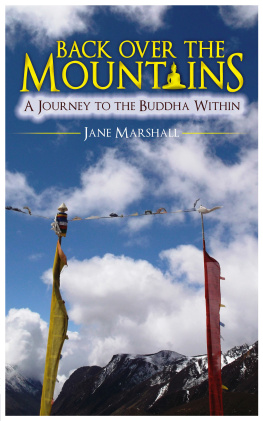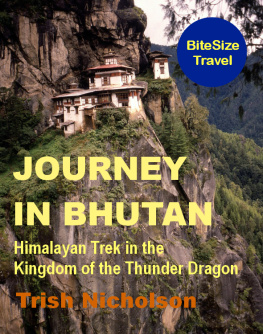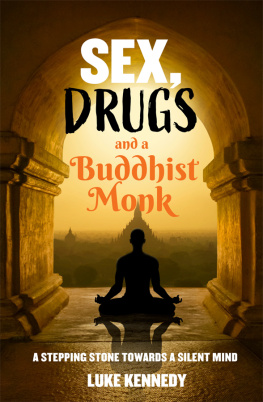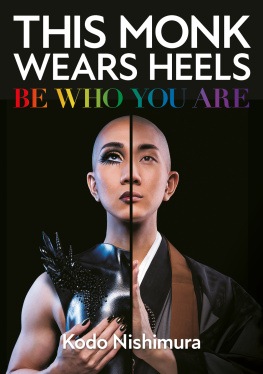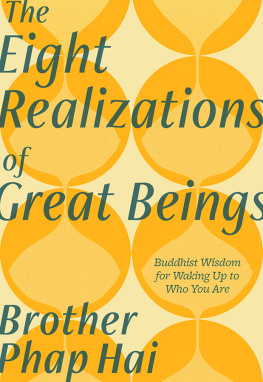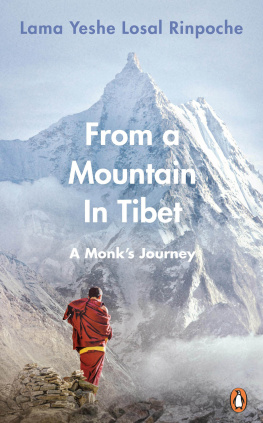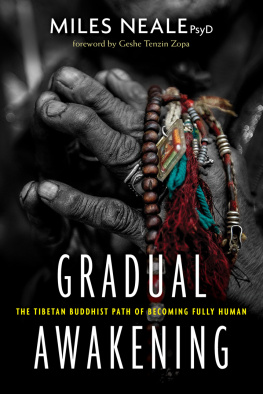
Canadian travel writer Jane Marshall grew up in Edmonton, North Americas northernmost major city. Its where her father died when she was just five years old, propelling her to seek happiness through travel.
She graduated from the University of Alberta in 2004 with an English major and Anthropology minor. Since then, she has built her freelance career through magazine and newspaper articles.
I have a thousand-year-old teacher. His name is Milarepa. He wandered the Himalayan borderlands without the promise of food or clothing. His temple was the earth, its roof the sky. An ancient hiker, a wanderer like me. I will trace his ancient pathways, and the pathways of my living teacher, Kushok, knowing that though one must learn through teachers, a teacher is also ones own mind. It is the Buddha within.
Hay House Publishers (India) Pvt. Ltd.
Muskaan Complex, Plot No.3, B-2 Vasant Kunj, New Delhi-110 070, India
Hay House Inc., PO Box 5100, Carlsbad, CA 92018-5100, USA
Hay House UK, Ltd., Astley House, 33 Notting Hill Gate, London W11 3JQ, UK
Hay House Australia Pty Ltd., 18/36 Ralph St., Alexandria NSW 2015, Australia
Hay House SA (Pty) Ltd., PO Box 990, Witkoppen 2068, South Africa
Hay House Publishing, Ltd., 17/F, One Hysan Ave., Causeway Bay, Hong Kong
Raincoast, 9050 Shaughnessy St., Vancouver, BC V6P 6E5, Canada
Email: contact@hayhouse.co.in
www.hayhouse.co.in
Copyright 2015 Jane Marshall
The views and opinions expressed in this book are the authors own and the facts are as reported by her. They have been verified to the extent possible, and the publishers are not in any way liable for the same.
While every effort has been made to trace copyright holders and quote them, this has not been possible in all cases. Any omissions, or wrongly quoted text, brought to our notice will be incorporated in the next edition.
All rights reserved. No part of this publication may be reproduced, by any mechanical, photographic, or electronic process, or in the form of a phonographic recording, nor may it be stored in a retrieval system, transmitted, or otherwise be copied for public or private use other than for fair use as brief quotations embodied in articles and reviews without prior written permission of the publisher.
The author of this book does not dispense medical advice or prescribe the use of any technique as a form of treatment for physical, emotional, or medical problems without the advice of a physician, either directly or indirectly. The intent of the author is only to offer information of a general nature to help you in your quest for emotional and spiritual well-being. In the event you use any of the information in this book for yourself which is your constitutional right the author and the publisher assume no responsibility for your actions.
ISBN 978-93-84544-36-2
ISBN 978-93-84544-37-9 (e-book)
Printed and bound at
Rajkamal Electric Press, Sonipat, Haryana (India)
To my husband, Mike,
who holds these places with ease inside himself.
His strength, open mindedness, and unyielding support
helped me carve out the stories that form this book.
And to Kushok, who opened the gate.
Ani Palkye: Kushoks mother. A temple keeper and aspiring nun at Gnung Nunnery in Kyedong, Tibet. She passed away when Kushok was a toddler.
Dorje: Kushoks father. He was a monk at Samtenling Monastery before abandoning his robes and marrying a village woman. Ani Palkye and Dorje had an affair that produced two children: Kushok, and an elder brother. He helped his brother, the 16th Drakar Rinpoche, run Drakar Taso Monastery.
Tsering Tashi: Kushoks maternal uncle. He helped Kushok escape to India in 1963 and now lives in Dharamsala, India.
Tashi Dolma: Kushoks maternal aunt, and Tsering Tashis sister. She raised Kushok after his mothers death until his escape. She passed away around 1990.
Phurbu Dolma: Cousin to Tsering Tashi and Tashi Dolma.
The 16th Drakar Rinpoche Tenzin Norbu: Kushoks paternal uncle. The 16th throne holder of Drakar Taso Monastery.
The 17th Drakar Rinpoche Drupgyud Tenpei Gyaltsen: The current Drakar Rinpoche. He lives in Kathmandu and cannot return to his rightful seat at Drakar Taso Monastery. A reclusive man, he is married, and prefers to be called Dorje.
Lopsang Chhiring Lama: My guide to Tsum Valley, Nepal, in 2012.
Geshe Tenzin Zopa: Born in Tsum Valley, he is the main character in the documentary Unmistaken Child, author of The Thousand Buddha Relic Stupa: Commemorating the Great Mahasdiddha Geshe Lama Konchok, and student of the late master Geshe Lama Konchog. Geshe Zopa recommended Lopsang as my guide.
Lama Sherap: The head lama of Nile Labrang. He lives at the Dub De O Sal Choling Monastery in Godawari, Nepal.
Khenpo Tenzing Lhundup: Lama Sheraps nephew, abbot of Dub De O Sal Choling Monastery, and a Shree Mangal Dvip graduate.
Khenpo Jampa Soepa: The abbot of the Kyedong Nunnery in Swyambhu, and affectionately called the jolly abbot in this book.
Thrangu Rinpoche: The 9th Thrangu tulku (reincarnation) and founder of Shree Mangal Dvip Boarding School.
Ive retold Kushok Lobsang Dhamches childhood based on his memories and the research I did during my travels. The book began as his biography, but as the story evolved, it became not only about Kushok, but about why his story mattered to me a woman with two children and an ache for spirituality since my fathers death, as well as spiritual seekers everywhere. Its been a long, exhausting, and blissful journey, as is the way with most spiritual endeavours.
Language and culture often provide differing perspectives, but I hope the essence of the story is what readers will take from this book. Im not a scholar of Tibetan history or Buddhism, but rather a woman travelling and experiencing a transforming landscape both without in the Himalayan borderlands; and within. I hope you enjoy this expedition.
Introduction
Tibet: the Land of Snows, the roof of the world. For centuries this mysterious Buddhist kingdom, locked away in its mountain fastness of the Himalaya, has exercised a unique hold on the imagination of the West. For explorers, imperialists and traders it was a forbidden land of treasure and riches. Dreamers on a spiritual quest have long whispered of a lost Shangri-la, steeped in magic and mystery.
Lonely Planet:Tibet
I was not immune to Tibets mysteries. Being a travel writer probably made me even more susceptible. I grew up with a mother who yearned for wild mountain spaces after my fathers job moved us from Calgary to Winnipeg to Edmonton in Canada. He died of bone cancer when I was 5 and we were left stranded on the plains. Mom kept us close to our friends, to the life wed created in our three years in Edmonton; close to my fathers grave at Mount Pleasant Cemetery, where she buried him, in case her girls ever needed to visit a physical location that held his memory.
We travelled often to the mountains for refuge. Mom lugged our ski gear to Sunshine Village in Banff so we could sniff the cold Rocky Mountain air in winter, or drove for hours with arguing children in the backseat to absorb sun on an alpine path and know the mountains solitude. Perhaps this was my dads true burial ground, where she could communicate with him. Upon our return, along the last stretch of Highway 2, shed weep for her sense of place in the world.
Perhaps thats why Ive pined for the mountains. They seem immortal not like human life that can be extinguished by a few rogue cells that decide to multiply into tumours. Their constancy is what Ive craved and when Im settled into their grand mass, I am home.
Next page
